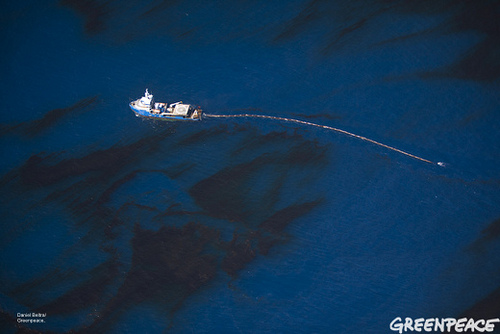 Methane from the BP oil spill was consumed by bacterial blooms.Photo: Greenpeace InternationalTwo months after the BP oil spill, scientists discovered methane concentrations in the Gulf of Mexico were a million times greater than background levels.
Methane from the BP oil spill was consumed by bacterial blooms.Photo: Greenpeace InternationalTwo months after the BP oil spill, scientists discovered methane concentrations in the Gulf of Mexico were a million times greater than background levels.
“Based on past data and research, we thought the methane would persist in those deeper plumes for years,” Dr. John Kessler, an assistant professor of oceanography at Texas A&M, said in an interview.
In June, Kessler and scientists from the University of California, Santa Barbara, led a research expedition to the Gulf to measure methane.
In a paper to be published today in Science Xpress, Kessler and his colleagues report that when they returned to the Gulf in September to take further measurements, they discovered that the methane had all but disappeared.
In the intervening months, bacterial blooms had dissolved some 200,000 tons of methane.
“There appears to be a rather substantial plume of methane-consuming organisms that seemed to have appeared sometime between when we left the water in June and when we returned to the water in September,” said Kessler.
A big question that had loomed back in June was how much of the methane, a potent greenhouse gas, would escape into the atmosphere. The oil spill offered a unique opportunity to gather data on how large releases of methane could affect the planet.
“We surveyed the entire deepwater plume, 36,000 square miles,” said Kessler. “We measured 207 different locations, and when we added up the oxygen deficit at each location we came up with a number that only can be explained when you have a complete consumption of that methane. If it had cycled to the atmosphere you would not have that oxygen content. Everywhere the methane should be there was a consistent oxygen deficit.”
Advanced analyzers made by Picarro, a Silicon Valley company, allowed Kessler and his colleagues to take continual real-time measurements of methane concentrations as their research vessel traveled the Gulf, resulting in an unprecedented accumulation of data. Older technology can only take measurements every five to 10 minutes.
While the impact on marine life of that oxygen deficit is unknown, Kessler noted that the methane plume was spread over a huge stretch of ocean and it took two months before the methane-eating bacterial blooms proliferated.
“You didn’t have that high a concentration of methane-eating organisms, so you don’t have nearly as much oxygen consumption in any one area,” he said.
The spill also offered some lessons for climate change. “What this ultimately told us is that at this location, at this depth and with this type of release, methane will stay in the deep water,” Kessler said. “It didn’t even come close to the surface.”
But he cautioned that would not necessarily be the case elsewhere.
“Methane releases in shallow waters will have much easier time making it to the atmosphere,” he said.



